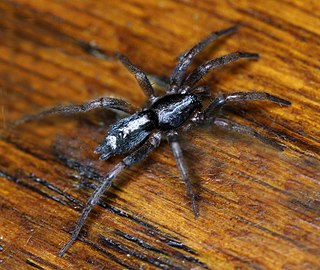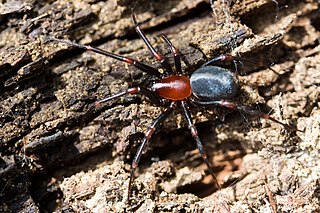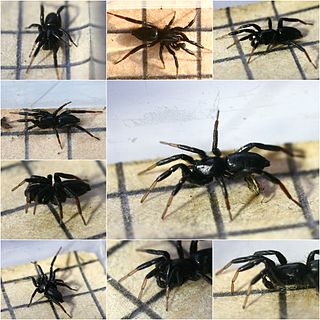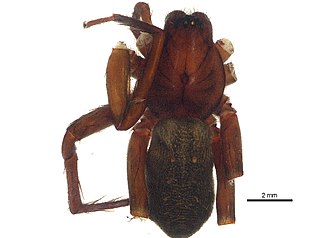
Oonopidae, also known as goblin spiders, is a family of spiders consisting of over 1,600 described species in about 113 genera worldwide, with total species diversity estimated at 2000 to 2500 species. The type genus of the family is OonopsKeyserling, 1835.

Cesonia is a genus of ground spiders that was first described by Eugène Simon in 1893.

Coneweb spiders (Diguetidae) are six-eyed haplogyne spiders that live in tangled space webs, fashioning a cone-like central retreat where they hide and lay eggs. It is a small family, containing only two genera split between a range in the Southwestern United States and Mexico and a range in South America. Members of the genus Diguetia usually build their webs in shrubs or between cactus pads. They have the same eye arrangement as the venomous recluse spiders, but none are known to be harmful to humans.

Caponiidae is a family of ecribellate haplogyne spiders that are unusual in a number of ways. They differ from other spiders in lacking book lungs and having the posterior median spinnerets anteriorly displaced to form a transverse row with the anterior lateral spinnerets. Most species have only two eyes, which is also unusual among spiders. A few species of Caponiidae variously have four, six or eight eyes. In some species the number of eyes will increase when the spiderling changes its skin as it grows towards adulthood.

Herpyllus is a genus of ground spiders first described by Nicholas Marcellus Hentz in 1832.

Kibramoa is a genus of North American plectreurid spiders that was first described by Ralph Vary Chamberlin in 1924.
Nopsides is a monotypic genus of North American araneomorph spiders in the family Caponiidae, containing the single species, Nopsides ceralbonus. It is one of three nopine species, in addition to Tarsonops and Orthonops, described by Ralph Vary Chamberlin from specimens collected from the Baja California region and nearby islands in 1924. They are active during the night, hiding under large stones of Mexico's deserts and xeric shrublands during the day.

Drassyllus is a genus of ground spiders that was first described by R. V. Chamberlin in 1922.
Scopoides is a genus of ground spiders that was first described by Norman I. Platnick in 1989.

Sergiolus is a genus of ground spiders that was first described by Eugène Simon in 1892. They are 3.3 to 9 millimetres long.
Sosticus is a genus of ground spiders that was first described by R. V. Chamberlin in 1922.
Synaphosus is a genus of ground spiders that was first described by Norman I. Platnick & M. U. Shadab in 1980.
Tivodrassus is a genus of Mexican long-spinneret ground spiders that was first described by Ralph Vary Chamberlin & Vaine Wilton Ivie in 1936. It was transferred to the ground spiders in 2018, but was returned to Prodidominae in 2022.

Anachemmis is a genus of North American false wolf spiders that was first described by Ralph Vary Chamberlin in 1919. It was briefly synonymized with Titiotus, but was reconfirmed as its own distinct genus in 1999.

Socalchemmis is a genus of North American false wolf spiders that was first described by Norman I. Platnick & D. Ubick in 2001. The genus name comes from a shortening of the phrase "Southern Californian Chemmis", as the genus was discovered in California.

Phrurotimpus is a genus of araneomorph spiders first described by R. V. Chamberlin and Wilton Ivie in 1935. The name is a compound adjective meaning "guarding the stone". Originally added to the Liocranidae, it was moved to the Corinnidae in 2002, then to the Phrurolithidae in 2014. They have red egg sacs that look like flattened discs, often found on the underside of stones.
Drassinella is a genus of North American araneomorph spiders in the family Phrurolithidae, first described by Nathan Banks in 1904.
Cinetomorpha is a genus of goblin spiders first described by Eugène Louis Simon in 1892. It is a senior synonym of Lucetia, and Yumates.










